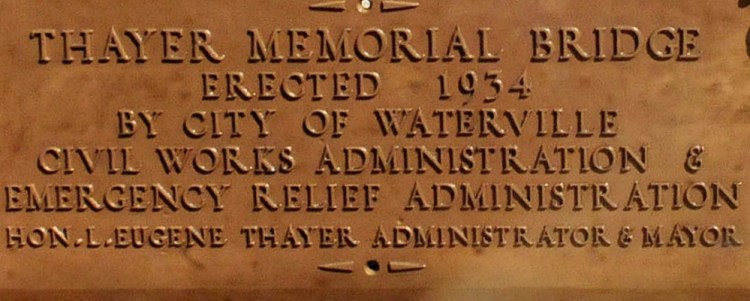WATERVILLE — The mystery of a bronze plaque, long-dead former Mayor Lorenzo Eugene Thayer and a bridge over Messalonskee Stream is beginning to unravel.
The plaque, imprinted with “Thayer Memorial Bridge,” surfaced recently when a man who didn’t give his name brought it to the Public Works complex, saying he thought the city might want it because it seemed to have historical significance.
City officials began researching Thayer and looking at city bridges to see where it could have belonged after it was dropped off. But they also wondered where it had been all these years.
After reading Sunday’s Morning Sentinel about the plaque’s mysterious reappearance, Jim Goodwin visited the newspaper’s offices Monday and said he’s the person who dropped it off.
Goodwin, owner of Goodwin’s Unlimited, a moving, landscaping and mowing business in Benton, said his crew had cleaned out a house about 10 years ago for a real estate company after the woman who lived in the house died. They found the 2-by-3-foot, 50-pound plaque in the basement under a pile of metal and other debris.
“I remember the guys coming back and they had a whole pile of metal and the plaque was in it,” Goodwin said. “I set it aside and said, ‘I’m going to bring it to town,’ but it sat there and sat there and sat there.”
For 10 years it lay in his business garage under a pile of plywood. During some down time several weeks ago, his crew cleaned the garage and rediscovered the plaque.
“I saw it and I said, ‘I got to bring it down to town,'” Goodwin said Monday. “I wasn’t even sure they’d want it.”
Goodwin, 57, said he read the Morning Sentinel story about city officials trying to solve the mystery Sunday morning.
“The plaque didn’t really look anything like the one I brought. I thought it was a piece of cast iron,” he said. “They did a good job cleaning that up.”
Goodwin says he would not have read about the plaque in the newspaper were it not for his high school current events teacher at Skowhegan Area High School — whose name he does not remember — who made the students read the paper every day. Goodwin said he came from a family that did not read newspapers, so he had never read one in his life until then. Over time, he grew to love reading the paper and he still does, every day.
“I’ve got to have that paper in the morning,” he said. “If I don’t have that paper in the morning, my whole day’s messed up.”
He thinks the house the plaque was found in was on Johnson Heights, and the father of eight said he plans to go back through his records for the last dozen or so years to try to find out exactly what house it was found in. None of the crew members who worked for him at the time are still with his business.
MORE MYSTERY
After Goodwin dropped off the plaque, city officials researched Thayer, who died in 1934 at age 51 while serving as mayor. They surmised the plaque was at one time on a city bridge and started inspecting the bridges.
Public Works Director Mark Turner discovered an indentation in the Gilman Street Bridge that perfectly fit the plaque. A city annual report from 1935 said that after Thayer died in 1934, city officials renamed the Gilman Street Bridge for Thayer.
Turner said Tuesday it looks as though someone pried the plaque — cleaned up now by a public works mechanic — off the bridge with a crowbar. “It’s slightly bent — it doesn’t lay flat — so that tells us that perhaps it was forced off, but we don’t know for sure.”
Turner has been in the area since the 1960s, but doesn’t recall seeing the plaque on the bridge.
But Laurie Joseph, 60, a Waterville High School graduate who grew up on Roberts Avenue near the bridge, said she remembers walking past it every day as a youth when she walked to her family’s business, Joseph’s Market on Front Street.
“I don’t remember much about being a kid, but I do remember that,” Joseph said. “We’d stop at the bridge and throw rocks in the water.”
The daughter of the late Peter Joseph, Joseph graduated from high school in 1973 and believes the plaque was still on the bridge then.
Upon learning Tuesday that Goodwin was the man who brought the plaque to the Public Works Department, Joseph said she knows him.
“He used to mow my daddy’s lawn.”
Waterville police Chief Joseph Massey said last week that the department does not keep records as far back as the ’60s and ’70s, but he contacted some former police officers who did and they vaguely recalled the theft of such a plaque.
FAMILY INVITED
Meanwhile, Turner and other city officials hope to return the plaque to the bridge in September on the 80th anniversary of when it was placed there to honor Thayer.
“We’d love to have Jim Goodwin attend the rededication ceremony when and if it occurs,” Turner said, adding that the city also would like relatives of Thayer to attend.
About a week before Goodwin brought the plaque to public works, Thayer’s great-nephew visited City Hall and had a conversation about Thayer with Amanda Esler, City Manager Michael Roy and Mayor Nick Isgro’s executive assistant.
Esler and Turner hope the man, who didn’t give his name, comes forward so they can learn more about Thayer and perhaps learn about the plaque’s disappearance.
Thayer and his wife, Florence, had two daughters, Ann, who died in 2008 at 94, and Mary, who died in 1975, according to Ann’s obituary.
Ann married Whitcomb Rummel Sr., and in 1947 they bought the Webber ice cream business in Waterville, which they ran as Rummel’s Ice Cream until 1972. It’s now Gifford’s Ice Cream.
The Rummels also owned The Silent Woman Restaurant on Kennedy Memorial Drive, which later became the Weathervane.
The Rummels had a son, Merrill, who at the time of Ann’s obituary in 2008, lived in Charleston, S.C., and Whitcomb Rummel Jr., of Chapel Hill, N.C. Ann and Whitcomb Sr. also had grandchildren and great grandchildren, according to her obituary.
Thayer was a Colby College graduate and one of the founders of the Morning Sentinel in 1904.
He served as the newspaper’s business manager in its early years. He headed the local Federal Relief Administration, helping the needy and unemployed, was affiliated with several insurance companies and was a member of civic and social organizations.
He had been in the hospital about two months, admitted for Bright’s disease, a kidney condition, before he died Sept. 3, 1934, of a cerebral hemorrhage.
Efforts to contact relatives of Thayer were unsuccessful as of Tuesday, including an email sent to Thayer’s grandson, Bill Rummel.
Turner said he found Thayer’s gravestone in Pine Grove Cemetery last week and told the long-dead mayor that although he had been long forgotten, he will be back in the news.
“‘You’re going to be a famous person,'” Turner said over the grave.
“He’s a forgotten person and now he’s going to come back to life. This is almost like it’s all pre-ordained or something — fate or destiny or whatever.”
Amy Calder — 861-9247
Twitter: @AmyCalder17
Send questions/comments to the editors.





Success. Please wait for the page to reload. If the page does not reload within 5 seconds, please refresh the page.
Enter your email and password to access comments.
Hi, to comment on stories you must . This profile is in addition to your subscription and website login.
Already have a commenting profile? .
Invalid username/password.
Please check your email to confirm and complete your registration.
Only subscribers are eligible to post comments. Please subscribe or login first for digital access. Here’s why.
Use the form below to reset your password. When you've submitted your account email, we will send an email with a reset code.